Category Archives: Race Reports
What’s your dream? (or “How do you keep yourself going for 24 hours and what do you think about?”)
~ by Angela White
I have been invited to write about my recent experiences of pushing the distance over 24 hours running. In particular, to answer the question, “How do you keep yourself going for 24 hours and what do you think about?”
Undertaking any endurance activity is tougher mentally than it is on the body. I used to think 60:40 but now feel it’s more like 70:30. I discovered the sport six years ago and initially, for me, it was more about walking than running. It is a fascinating and revealing learning experience in which I still consider myself to be something of a novice. Each event gives me more information about myself and how I respond to the physical, mental and emotional challenges that it offers. Practically, that means that I can find myself re-framing many aspects of my approach to, and participation in, the next challenge.
Setting out on an event, my main objectives are to get to my destination quickly, safely and in the ‘best condition’ possible. The ‘best condition’ to me means that I am not totally dehydrated or underfed and, crucially, that I conduct myself in a way that enables my body to recover quickly afterwards. Each event itself is training and building upon what has gone before, and focusing on optimising recovery should, in my view, be as an important a part of the plan as running a good race.
This requires considerable preparation and planning beforehand. During the event, it takes a variety of skills, concentration and drawing upon a wide array of cognitive abilities.
As with any other mode of transport, running requires that you know your destination and your route to get there. You need to have enough fuel and water in the tank and a good idea of your rate of consumption and a plan as to how and when to fill up. Knowing where the ascents and descents are and having an idea at which point in the event you will need to tackle them is also helpful.
Alongside these basics is the need to manage temperature regulation. One thing I have learned is that, once I become fatigued, I don’t manage the cold and I have suffered from hypothermia on more than one occasion. In addition, well before that occurs, my leg muscles, particularly the iliotibial band and around the hip, stiffen and adversely affect my gait.
I’m therefore dividing my attention between a lot of factors and that’s before I’m looking at the detail of the road or trail surface to dodge potholes, rabbit holes, innocent-looking protruding rocks, puddles and piles of leaves covering hazards for the unwary to say nothing of being shocked and astounded at the behaviours and antics of other road users! These all present a need for constant visual attention and scanning of my immediate and upcoming environment both for navigation but as part of a need to rapidly process information on hazards to react quickly enough to avoid them. Developing good foot-eye coordination is also not to be underestimated.
Running on roads, in particular, places demands on auditory input and spatial awareness. Listening out for vehicles approaching from behind and making judgements on their proximity and speed and whether they have seen you and are taking care to modify their driving to respect you as a fellow road user. I am challenged by this as I am profoundly deaf in one ear having suffered from sensorineural deafness one afternoon seven years ago. Not only does this mono-hearing mean that I am unable to pinpoint the direction a noise is coming from but, it also left me with severe tinnitus on that side which is activated proportionately to constant noise such as wind, water, traffic, and conversation. This can become so loud that it masks the noises coming into my good ear and effectively renders me totally deaf.
Performing these functions for the most part occupy my thinking throughout each event. They feed into an outline plan for the event and dynamically modify it according to how the race unfolds.
Escape from Meriden, EFM
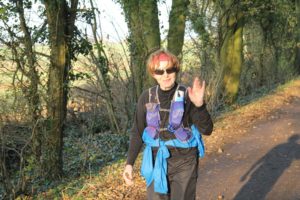
At midnight on Friday 17th November I commenced the last of a triad of 24 hour races in three months. This was Escape from Meriden.

In each of the first and second of these I had achieved over 90 miles but had finished each with some very nasty, painful blistering which had started some hours prior to the end. Unsurprisingly this had slowed me considerably. How do you deal with such things? It’s an issue I am still trying to work out and it is not very scientific. I have tried different shoes and a variety of cushioning and taping measures. I’ve spent a fortune on podiatrist and orthotics. The big challenge is testing what works as this can only be done by going out and running another very long way which, of course, you just don’t do in training. So essentially it is only during the next race when you find out whether something works – or not.
EFM is an event where you choose your own route. You have 24 hours to get as far from Meriden, the centre of England as you can, on foot. However, your final distance is measured as the crow flies so one needs to be as efficient as possible with route choice. My strategy was to head for a roman road and stick to that, hence the Fosse Way to the southwest was my plan.
Over a hundred competitors lit up like Christmas trees with a variety of head torches, bike lights and glow bands the colours of the rainbow gathered at the 500 year-old cross in Meriden excitedly awaiting the start. It was drizzling, the sort of wet that clings and penetrates slowly over time so you don’t appreciate how wet you’re getting. At the race director’s shout we were off, heading in multiple directions from the cross, many sprinting as if their life depended upon it. Finger on my Garmin, I pressed start to record my run but also to provide crucial feedback to guide me through it.
My next thought was to remind myself that I have a long way to go, ignore the pack. If anyone is on your route, you’ll be seeing them soon enough. I do a quick systems check: are my shoes and clothes comfortable, anything twisted or rubbing, head-torch giving me optimum view of the road surface. I check my race vest pockets, map top left, fluid top right, zips definitely closed. Check the map, right turn coming up and, yes about a mile along here I’ll meet the crew. This is a self-supporting event and you are allowed to have folks help you along the way. I was fortunate to have a series of three family members who would each leap frog me along my route. I had given each of them a set of marked maps, a provisional timing schedule together with what I thought I would need and where.
My Garmin vibrated on my left wrist alerting me to completion of the first mile. This was my cue to walk for a minute whilst drinking. I have employed this tactic a number of times and find it useful in long events to make sure I give time to hydration and fuelling but also a brief period to flush out toxic metabolites from the legs. I also believe an intermittent change of gait helps minimise complications of repetitive stress injuries such as anterior tibial tendinitis, suffered by so many endurance runners.
I passed the crew with a brief acknowledgement that all was well and that I’d see them at the next stop in five miles. Map in hand, I check the nav and took the next right turn and headed into the darkened lane. Most runners had dispersed and there were just four sets of flashing lights bobbing along the road ahead of me. From the map I was expecting to cross a railway line, and there it was, followed by roundabout and then turn left onto a lit road through a village. I was on this for a mile so switched my head torch off taking advantage of the street lighting to save battery.
As my Garmin buzzed for my attention I walked, ate and drank my way along. When running I tried to keep my pace to between 10 and 12 minute miles. I had a long way to go. The road surface was wet, lots of leaves, bad cambers, try to keep to the middle, fortunately not a lot of traffic in the lanes. Plenty of noise to sharpen the senses, rain drops from the trees on my jacket hood, scurrying of small animals in hedges whose nocturnal hunting I had disturbed and larger animals in fields who didn’t seem particularly alarmed by a mad human running by in the night.
I was aware it was cold, around 3 degrees and welcomed the hot chocolate the crew handed me along with a snack bar when we next met. I walked along drinking it. Every stationary moment might be rued in the final analysis should you have not optimised these transition times. As they drove at my pace past me ten minutes later I was again running and simply dropped the mug through the vehicle window.
My mind is constantly watching the nav, looking at the road surface and being aware of the environment to manage hazard avoidance, responding to my watch to fuel and hydrate and checking pace. 25 miles in and I was asked when I’d like my porridge to which I replied at the bottom of the next hill. A further mile on and I gladly accepted a hot porridge pot which I ate while slowly climbing the hill and handing the pot back as the crew passed me. The next stop was to be a handover between two crews.
My watch told me I was ahead of time by up to 30 minutes. Was this good or bad? I decided it was equivocal. 30 miles in 5 hours 30 minutes was ok at this stage. However, things can change rapidly. Within minutes as I climbed higher into the Cotswolds, the drizzly mist turned to thick freezing fog and visibility was reduced to just two or three feet. A systems check identified my legs around hips and thighs were rapidly stiffening and felt cold. I pushed on up the hill whilst planning what I needed from the crew to deal with this change of weather.
I was pleased to see my two crews had met up and I jumped into the awaiting van. I started to strip off my upper layers whilst asking for a very specific change of clothes and waterproofs. Another hot chocolate was ready and I took a few sips. With the luxury of dry baselayers, a warm mid layer and waterproof legs and jacket I quickly headed out with my hot chocolate and with the crew saying they’d keep closer during this weather.
The diffusion and distortion of the light from my head torch into the dense fog was disorientating and there was nothing for it but to walk carefully for two hours until night turned to day and I could see my way more clearly.
During this time I was calculating the impact that my slowed pace could have on the final outcome and what, if anything I could do to make up for lost time when I was running again, and came up with a plan.
As the daylight progressed, the fog was replaced by glorious autumnal sunshine which proudly displayed the next twenty miles of thoroughly enjoyable ‘undulating’ Cotswold countryside, looking every bit the 19th century oil painting, unspoiled by time.
As I warmed through I discarded my layers. I also deployed my plan, a ‘secret weapon’ I had been looking for an opportunity to try out. This was a caffeine shot made from concentrated green tea extract. I was interested to see the results. I had made sure to eat plenty during my enforced walk so I had ready calories to burn. I was pleasantly surprised by the results. I had expected a seriously high spike in energy and activity and a possible rapid burn out; instead it was more of a persistent gentle boost which saw me running steadily through this beautiful landscape all the while feeling how lucky I was and how alive I felt at that moment. I reached Compton Abdale, the fifty-mile point at 10am which meant I had regained my hopeful schedule. Furthermore, I was through the other side of Cirencester an hour up.
Fortunately, crew number three had been tracking progress and had headed up to take over from number two at Kemble in time for my arrival.
Things were beginning to hurt a bit now too. I tried to change shoes for the off-road Fosseway but my feet objected. I therefore moved straight into my second pair of road shoes which were a size bigger and different make with a wider toebox. It was a rather slower traverse of the Fosseway through to The Gib and into the second night. I had already blistered and taken a few minutes out to deal with the problem but I was taking a bit of time to adapt to the discomfort. The bitter wind did its best to be my undoing but my thermoregulation was well awry. Hardly surprising as by now I had been awake for 34 hours. However, rather than the usual hypothermia, I felt I was burning up so the cold was, in part, welcome.
A friend in the south had come out and cycled alongside for a few hours. It seemed rude not to try and move a bit more quickly as it was jolly cold and he was on the brakes going down the hills. I had another plan to use the secret weapon again but before I could allow myself to do that I needed to take some painkillers else I knew it would really hurt! I worked out what time I needed to take everything and to eat enough.
My aim, you see was not just to make the 24 hours but to reach 100 miles in that time. This was the first time in the whole race that I began to believe it might really be possible. I remained cautiously optimistic and focused on putting one foot in front of the other.
I picked up the pace on the steep descent into Bath and met up with the crew. A few seconds to do what was needed and then straight off again. Would it work again? Was I asking too much after this time awake?
“How long does it take to work?” Asked my friend. I wasn’t sure but started to run again. I know Bath well and didn’t need maps now. I discarded everything apart from base clothing and the tracker which I carried in my hand. What followed was an exciting caffeine-fuelled sprint across the city. I knew this would be my last chance to pick up speed and miles. I heard him say “Gosh, you’re rattling along”, and looking down at my watch I noted my pace was 8 mins 50 seconds. Just how is that possible when you’ve been up for 36 hours and in which you’ve run over 90 miles in the last 20 hours?
South of Bath, ahead on my route, were some hills which would prove a final test. My cyclist friend is the best company on these events, well experienced in endurance sports and has run with me on many occasions. He departed the far side of Bath after the first and biggest ascent with aching wrists but the knowledge he’d given me a huge morale boost.
I had nothing left to plan, I was not going to take any risks with my health with artificial stimulants – they’d proven their worth. I also wanted to sleep at the end of this.
A hundred was in sight but it was to be a battle. Mind over matter. I desperately wanted to sleep now, just to slump to the ground where I was and shut my eyes. It was so very hard. With next to nothing left in the tank physically and an enormous struggle mentally I forged my way onwards and upwards…….and down ……and up….. getting slower and slower…….mindful of each and every one of the 0.01 miles ticking up laboriously on my watch, and painfully in my being.
My son accompanied me on those last miles distracting me by reading out the many lovely and encouraging comments that friends had made on social media. I still wanted to sleep but my one thought was to get across that 100 mile barrier. “Are we there yet?”, he asked, I denied it and made sure that we continued to a bit beyond. The last thing I wanted was for Garmin to recalculate my route during its upload and take any of my hard earned century away from me.
In the final analysis I achieved my personal objective and ran 100.2 miles with 6,332 feet of ascent. So far as the race itself is concerned, I covered 87.26 miles as the crow flew that night, came first lady, fifth overall and gained the Duke of York trophy for the most ascent.
![]()

There are highs and lows, deep dark lows, in any event but no matter how low it feels at the time, it’s just pain, or fatigue and it will pass whilst your achievement is there forever. Re-frame each and every physical struggle mentally and it will help you over it. It is rare in an event like this that there is nothing connected with the event to think about or to admire around me. On really tough physical bits I count and do maths problems. Sometimes the maths becomes quite complex and I don’t remember what the original question was but the point is, it doesn’t matter as it got me up that mountain, it gave the painkillers time to work, it took my mind off the weather or, for me, that scary bit of exposed mountainside.
I found this sport late in life but I think I’m more alive now than I’ve ever been. I’m curious as to just what is possible. It has taken a huge amount of hard work. I’ve had many disappointments, broken bones and very low points. I have also met some lovely people and made some great like-minded friends. I’ve met and know some very remarkable people, all who’ve worked to achieve their own ‘impossible’. In a few short years I have pushed my own boundaries well beyond my imagination – despite loud protestations from well-meaning friends. Never put limits on your dreams nor let anyone else do so for you. If I had listened to them, I wouldn’t be living life now.
“You’re never too old to set a new goal or dream a new dream” said C. S. Lewis
What’s your dream?
Thank you for reading and I’d love to hear what strategies you use to keep you going.
Angela White
December 2018
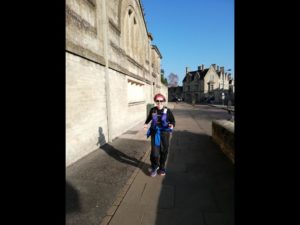
Jurassicman DNF
~ by Nat
I’ve been enjoying life as part of Kendal Tri for a few years now, and I generally respond well to a bit of a challenge. I first did Kendal Sprint four years ago, the day after my first century ride (Wiggle’s Yorkshire sportive). I then got to know Chris and Sarah Ruston; Chris convinced me my next tri should be “A Day in the Lakes”, a hilly half-iron (pre storm Desmond so Kirkstone and Shap were still in the route)… a tough but enjoyable challenge and I was hooked.
Jump forward to 2018 and I was harbouring a secret challenge. Spring went well. I was regularly enjoying hilly runs, gradually upping the distance; also hitting quite a few hills on the bike, on and off road. I generally enter the Wheelbase Spring classic and this year was no exception, the difference being that this year I got stronger as the day went on. My next challenge was the Lakeland Loop; longer, more climbing, and finished with Hardknot, Wrynose, and Blea Tarn. Another successful day out. A few people started asking what I was training towards; I told everyone I was training for Struggle Dales (107miles with nearly 11’000ft of up) and my Coniston Trail Marathon (my first marathon)…this was the truth, but not the whole truth. I’d also signed up for Jurassicman, a full iron-distance sufferfest on the Jurassic coast!
Struggle Dales and Coniston Marathon were on consecutive weekends at the end of May / start of June. Hot, hard, and thoroughly enjoyable. While both of these events took a lot out of me neither of them totally wiped me out. I took a little confidence from this for my ‘big secret’, had a couple of easier weeks, then started building the training back up.
July I had some different work to normal, two weeks supporting an English coast-to-coast for a National Geographic holiday group. I enjoy the work, but it meant two weeks away from my normal routine, two weeks of loading and unloading large suitcases into a minibus, two weeks of very soft beds, two weeks without any floorspace for doing my daily core-strength stuff. Day 8 of 13 I had a bit of a back twinge, but I told myself it was only minor. Day 10 another, a little worse. Day 13 I got home; tired, sore and a little concerned as race day was just over 4 weeks away. Over the next couple of days I discovered that any running or biking aggravated my back, my final couple of “peak” training weeks were a write-off.
To put a little back story on this. I’ve had intermittent back issues all my adult life, since a serious hip injury in my late teens. I generally manage it through a mixture of core strength work and the superb team at Body Rehab.
I spent the next few weeks basically s****ing myself about the race. Not training…but trying to resolve my stiff and twinging back; but also had several depressed days of comfort eating. Mid-August came round, and despite feeling nervous and unfit I decided that I had to at least give it a go; I would have regretted not trying.
Friday 17th I headed south. Saturday 18th I arrived at race HQ (a campsite) and checked in. I had a little walk, checked my kit (yet again), deposited the appropriately labelled bags with the right people, and cooked dinner. I chatted to some of my fellow racers, great people, then headed to bed ready for the stupidly early start. The howling storm outside didn’t exactly aid a restful night.
Sunday 19th: up, breakfast, dressed, final prep, 2nd breakfast, then head for the minibus…all before dawn. The logistics that Brutal Events provide are excellent, as is their whole team. We were shuttled down to Budleigh Salterton for the race briefing where we saw the effects of the previous couple of days of wind. Apparently some people withdrew from race after looking at the sea (they’re the sensible ones), undoubtedly the roughest water I’ve ever swam in and the colour of red house bricks with all the churned up sediment. The course was changed slightly to make it easier to manage for the safety cover. Out through the huge waves to the first bouy, 90degree turn, then 6 laps of a lateral out/back parallel to the beach. Swimming was an erratic affair to say the least, I don’t think I linked more than two “normal” strokes together in the entire 2.4miles. While being tumbled back towards the beach after my 6th lap I vomited for a third time, and felt my back spasming as I did so. I landed next to startled looking marshall who checked I was ok before helping me to my feet and pointing me up the beach. 1hr33min, I’d hoped for around 1hr20 in good water so was fairly happy with that. I took my time in T1 knowing that I had a long day ahead. I spoke to some other racers, who all agreed that we’d just survived the most epic swim of our lives; I even did a few stretches to check my back out before heading out.
The Jurassic coast may not have any mountains, but it certainly has steep roads. The 112miles to Swanage has over 8’600ft of climbing on them, all of which I’d ridden in May so I knew what to expect. Aware of my back I did a few sums, and came up with an average speed that would get me into T2 with about an hour to spare (figuring I would use up some of that time at the feed stations, and the rest was saved for mechanicals / unexpected issues). The harshest climbs all come in the first 40 miles and a group of around 7 or 8 of us all kept leap frogging each other depending on where our strengths lay. The first feed station came after a few climbs and I was spinning along nicely. 60something miles in and my back had another little twinge, I stood in the pedals and moved my back around as best I could, then settled back in. After that each incline got slower, and more painful. The 500ft climb out of Portesham at around 70miles had my back screaming, but knowing that after that climb it was a gentle descent to the next feed station at 77miles I figured push on and deal with it there.
I rolled into the feed station in agony, and struggling to breathe. Unclipped my left foot, couldn’t unclip my right. The two guys at the feed station were awesome. They helped me off my bike, at which point I looked like I had scoliosis with my chest pulled a considerable distance to the right by the spasms. They very kindly and gently told me my day was over (although I guess I already knew), and kept me warm and fed while sorting transport out and contacting the organisers. I was gutted, but I always knew it was a gamble. I was even more disappointed because this years Jurassicman was advertised as being the final one, no second chances.
I can’t speak highly enough about all the organisers / marshalls / etc at Brutal events. I was so well looked after. I was taken to the finish (a village hall) re-united with my spare clothing, fed and watered, and frequently checked on (including being offered a lift to hospital, which I refused, it’s not the first time I’ve been through this sort of thing…although it’s not often I get a couple of inches out of alignment).
Nearly two months later I’m still dealing with the aftermath; some days I’m feeling strong, other days I need to do several rounds of exercises and it takes 20minutes to put my socks on. It’s certainly been a season of mixed fortunes. But now is the important bit… Assess, learn, apply.
Positives:
I’ve learnt to love hills, on the bike & on foot.
I’ve learnt how to fuel myself correctly.
I’ve discovered I can train for 100+ mile hilly rides and hilly marathons at the same time.
Making changes:
Moving forward I’ll be keeping Yoga and strength training in my programme all year round.
Tips:
Learn what your body needs, and make opportunities not excuses.
Never ignore a niggle.
On an additional note. I’ve recently discovered that Jurassicman will return in 2020…..Who fancies a challenge?
Swim Run Fun !
Recently I took part in my first Swim Run Event the ‘BRECA Buttermere Sprint’ and I loved it! The event consisted of nine run stages (shortest was 100m, longest 7.8k) and eight swim sections (shortest was 300m, longest 600m). I teamed up with my friend Sheona Southern and we entered as ‘Yaya Sisterhood!’
Neither of us had done a Swim Run before but were up for having a go; we realised that there were some decisions to make before we turned up on race day such as: What kit did we need? How would we race as a team?
We had no time to train together or try out our kit so we decided to have a relaxed approach and enjoy the day out. As preparation we watched YouTube clips and had several helpful conversations with people who had experience of Swim Runs; then via email and text Sheona and I agreed our approach to the day. We decided to use some old fell running trainers and invest in a Swim Run wetsuit (a new wet suit is not necessary as there are other more cost-effective options).
Also, there are optional kit items, e.g. pull buoys, paddles, tethers and neoprene calf guards. We decided not to use paddles as we have not trained with them (they can cause shoulder injuries if your muscles are not used to swimming with them). We did not to use tethers, they can be useful on swims and runs; I had used them on previous adventure races but not swimming and there is a knack to using them effectively (attaching and removing them or getting them tangled and knotted up can take longer than any time advantage gained using them). Finally, whilst we had both made adaptations to our pull buoys to use on the day Sheona decided to go with the calf guards.
The event start was at Derwent Hill Outdoor Centre and we had booked overnight accommodation, so with an 8am breakfast, 9am briefing and 11am start we were excited about the morning lie in! We arrived at 8pm Friday evening, dumped our bags and headed off to the pub (only 10 mins walk – result!); after all we had agreed a relaxed approach to the event, which meant lots of chat and a couple of glasses of wine. We bumped into another newbie team at the bar that had a similar approach to us and swapped stories with them for a while.
After a comfortable night’s rest and a hearty breakfast, we registered, listened to the briefing which was relaxed and friendly; in fact over half of the teams were doing their first Swim Run event so we were not alone. We then headed back to our rooms and embarked on our one and only team training session; how to take our wetsuit tops off and put them back on whilst running and wearing the race vest. After a bit of giggling and messing about we came up with a system that we hoped would work. We then wrote the distance of each section on the back of our hands with a permanent pen (I wrote the swim legs and Sheona the run legs) and headed down to the start.
We began to feel nervous as we waited at the start and so headed off for a short warm up and tried to relax. Soon the start hooter sounded and we were off down the field for 500m and into the lake for the first 400m swim or so we thought! We were able to run through the water for the first 200m and then it was deep enough to swim side by side and breathing together so we could keep an eye of each other. This seemed to work well and over the event as swimmers on each leg thinned out spotting each other became easier. Due to our different swim speeds drafting didn’t work so well (although on reflection practicing using a tether would help this).
Then we were out of the water and onto the short run before soon being back in the lake for the next leg. We had decided to only take our swim hats and goggles off if it was a longer run or if we were getting too hot; this meant we could keep moving quicker through the transitions. Sheona had not had chance to do any swim training and it was two years since she swam regularly (she had been training for a 200 mile bike charity bike ride), and she found she got dizzy switching from swim to run and visa versa; so, as we approached the second swim section she tripped and fell landing heavily on her shoulder but seemed ok to keep going.
Before we started the event, I thought that I might get frustrated with the short legs and constantly changing from swim to run, however this was not the case as time passed really quickly and we were soon onto one of the two long run sections. We were not feeling hot so decided to keep our wetsuit tops on as we expected the run to take us no more than 35mins. Towards the end of this section was a feed station so we took water with our new reusable cups (a mandatory kit item), grabbed a couple of jelly babies and headed off towards the next swim section. We were also quite excited about the next feed station which was going to have cold potatoes and salt… still we would have to wait for that treat!
There is not much more to say about the event itself other than we swam and ran though amazing scenery; the water was a bit choppy and we enjoyed it. Suddenly we were onto the penultimate run leg which was 7.6k with some ascent. The final feed station did not disappoint, the cold potatoes were ace! By now the day was hot and sunny so Sheona decided to run with her wetsuit top down, which was great as we were able to test out our system and it worked well.
As we arrived for the final swim we were told that the entry was a bit muddy, which was an understatement; we found that the best way to travel across 250m of the final 300m swim was to lie on our fronts in the water and to pull ourselves along using the weed and mud below as it was too shallow to swim and too muddy to run. A final 50m swim brought us out just below Derwent Hill Centre and the finish line. We set off running and took look a quick look behind us to make sure that we were not going to be overtaken by any other teams, then we slowed down and tried to get the mud out of our hair and smarten ourselves up for the finish; we didn’t want to look too muddy for our finish line shots…and then we were being cheered over the line, we had finished and were not too wrecked!
We were still laughing and after a drink and food from the BBQ we were feeling good and happy with our day out. We have learnt lots and hopefully I can persuade Sheona to do another one next year. We have learnt loads and know we could improve on our times and still have fun; I am sure that I will do more Swim Runs and would like to go for one of the longer events next year.
Coniston Standard
~by Steven Vaughan
This is a sort of transition (no pun intended) back to racing seriously again year, so I’m focused but trying to make sure I enjoy myself and don’t get lost in the obsession of it all! So, I’ve done early season races with the University of Stirling where I’m studying at the moment, but bizarrely as the undergraduates have all gone home the Uni season is finished!! Therefore, I am taking part in a few local races (in between trying to collect Wainwright’s!). I competed at Coniston when it first started and again in about 2012 (I think it was). This is not a race that is enhanced by bad weather….. therefore I entered last Wednesday, once I was sure the rain was staying away! And what weather, pretty much perfect as far as I was concerned, though some might have found it a bit warm.
Setting: on the edge of Lake Coniston (though bike transition is up the hill – more of that in a moment). Simply stunning.
Organiser: Epic Events, sanctioned by British Triathlon (with referees present).
Registration: Saturday afternoon or Sunday morning in time for a social 8am start (no 3am feast required).
Participants: 168 finishers
Swim: it was a balmy 17c in the lake. One lap of a buoyed rectangular course (not really swimming directly into the sun, except on the short end of the course). Deep water start, split into 2 groups with faster swimmers going off a couple of minutes early, removing that unpleasantness of faster swimmers starting At the back and coming through.
Transition 1: it is a bit of a pain to get to T1 as the bikes have to be racked about 800m up a little hill (in the early years transition was by the lake but the locals on road exit complained so it was a case of move transition up to a top field or cancel). Anyhow it means taking wetsuit off, putting some trainers on and running up. I’m not a big fan of uphill, but it’s not too terrible.
Bike: bike course is a little bit lumpy (my Strava has 595m of vertical). The ride heads out through Torver, on the A593 until A595 which you follow over the big hill at about half way (but do get the down too) before crossing back to Lowick Bridge and heading back to Torver. The views in places are awesome; of course I was concentrating! I decided I’m not strong enough for my TT bike given the undulations, which for me was the right call. But that’s very much personal preference. There were a mix of road, road with clip on bars and TT bikes.
Transition 2: have to dismount and cross the road, but was ok. A car following me actually stopped to let me cross. Little run down the field and trainers on
Run: the advantage of the run up to transition is the run is down to start. As you leave the campsite/farm, follow the main walking (gravel) track to Coniston village (a little up and down) and then flat paths/cycle tracks before going left up a stretch of off-road to get the distance in, this is a bit of a kick although only about 30-40m of vertical change was enough to catch some people out. There were water bottles at the turn. Then it’s back the way you came (minus transition hill)
Finish: alongside the lake, there was a commentator dressed up to encourage and greet everyone back. Prizes for overall M/F 1,2,3 plus age groups (10 yr groups from 40+). Everyone gets a tshirt and finisher medal.
Reflections: This isn’t a course for a PB – the winning time was 2h15! But I had a good race, enjoyed it and finished higher up the field than I expected. Also managed to get sunburnt and be back home in time for the England game. In a nice touch, Epic upload race pictures for no extra cost to their Facebook page; shame I missed the opportunity to get Kendal kit, but the Uni are pleased I wore theirs!
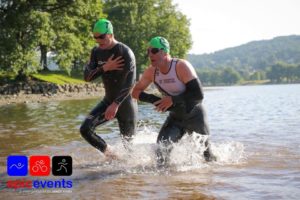
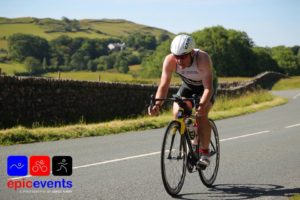
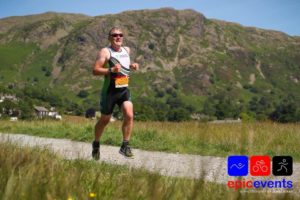
Eton Dorney Para Tri
~by Kath Finn
I have just returned from the Eton Dorney Para Triathlon World Cup which was a very interesting race! I was supporting Andrea Logan who is visually impaired in her first triathlon with an open water swim. It was at Dorney Rowing Lake, Slough, (long way…thanks for all the driving Paddy Finn) water warm and everything flat. We were in the open race in the para wave -first race I’ve ever been to with one of them. We had a hard but successful swim, our own private canoe escort, and fifteen grinning helpers to pull us out. Good bike and ok run. Andrea did fantastically – a lot of fun, some learning and a great day out. It was really interesting watching the Para World Cup race and thinking of the effort going in to racing as a para. Wheelchair users need 2 chairs and a hand cycle (total second hand £10,000) and two or three ‘handlers’ at swim entrance and exit, also a large van to put all the kit in to travel from Italy or wherever. And as for those form South Africa and Australia! If you have one arm you have all bike controls and gears on one tri bar…anyone fancy that. And if your stump has a holder on the bike you just hop off and hop to transition on your only leg to attach your blade for the run. So many variations.
It takes a lot to access tri sometimes – in this instance thanks to Bendrigg who started it all and loaned us the bike, Chrissie Johnstone, Sleeker Swim, who gave us help with swimming and Aiguille Outdoor equipment who helped us with tethers.
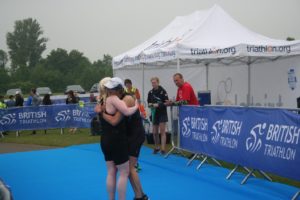
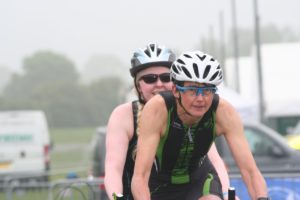
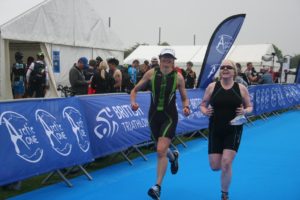
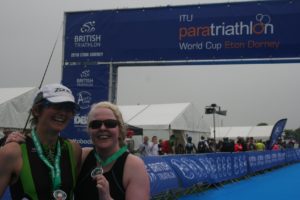
We do like to be beside the seaside…
~by John Moreton
Southport Standard Tri – 20/5/18
This is a well organised event, I think around 1400 athletes entered the various distances on the day, from the sprint to the standard, 2019 ETU Sprint Distance Qualifier, 2018 ITU Standard Distance Qualifier, Triathlon England National Standard Distance Championships, BUCS Standard Distance Championships. There was a lot going on.
We were running a little behind when my wave started (wave 7) but not by much and not of any concern. The briefing for the waves was conducted on the ramp into the water and we started immediately afterwards. The weather on the day was near perfect, no wind, warm, and sunny… From memory I think the water was around 16 degrees!
Open water 1.5km; this is a man-made lake so is relatively shallow, I heard someone say about 4ft in most places. But, the bottom is deep silt and mingy, by the time my wave started there was a lot of silt
in the water. Black and smelly! We were grouped into around 20 or 30, perhaps more for some waves but there seemed enough space and although I got my legs swum over and goggles nocked skew, I think it was quite civilized. Twice around the island then out on the other side of the small bay. Head-checking is necessary to keep a good line and avoid rogue swimmers who seemed to be swimming for places unknown! For me the swim was actually better than I had expected. A practice open water swim the week before with the COLTS helped immensely and was probably the best bit of prep I did. I was a little faster on the swim than I thought I would be and left the water around in 31:41. Note to self to watch balance on getting out as I found all the turning of the head during the swim made me a little unsteady for a few steps on getting out. I needed a few paces to get my land head back on!
T1 Transition was as planned but it’s a bugger to get the wetsuit off when you are hurrying, and I could have made it easier if I had removed my watch first! Timed as 6:19 this was longer than it felt. As I did in Kendal Sprint I had too much gear there and didn’t use half of it. But you never know with the weather I suppose, or at least I don’t.
The bike leg is 40km dead flat, or a variance of only a few metres. South for 5km then turn around, and north past the transition for another 5km, turnaround, and back making each circuit 20km. Than
k god there was no headwind as I think this place could be truly brutal if there is a wind! Even so, being this flat made it challenging and strangely I found myself wishing for a hill or two and a bit of a break from the constant pedalling. In future I would treat a flat ride with greater respect and perhaps train with more specificity. 1:26 which is fast for me, but I got passed a lot. I think being new I am still getting the leg condition to really press on with the bike. Need some work there.
T2. Once again transition was straightforward 3:30 this time as not much too do except grab a couple of gels and put the runners on. Finally, I found myself feeling at home here as my background is running and ultras. It was pretty warm, but nice to start pinching back a couple of spots (not many though!) The run goes around the lake twice, its well signed and marshalled and there is drinking water at the halfway 5km mark. There was no chance of taking a wrong turn or getting lost even with the weird double back, figure eight loopy thing half way through the lap. I think this was to get the distance up. So full marks to the marshals and directions getting people around there. Still no wind so again a relief. Finished the run in 59:13, not fast but happy. All up 3Hrs 7mins.
I am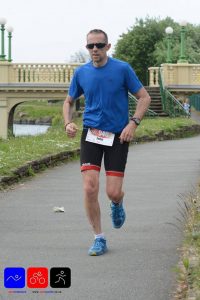 very new to triathlons, so this is by no means a ‘how to’ of the business of racing them. Just observations and mistakes from a newbie on the subject and perhaps some insights too. Overall, I think this was a good triathlon. Results were texted to my phone within minutes of the finish which was great. The race was bigger than Kendal Sprint (my only other tri) and had the feel of a large event. Which I guess it was!
very new to triathlons, so this is by no means a ‘how to’ of the business of racing them. Just observations and mistakes from a newbie on the subject and perhaps some insights too. Overall, I think this was a good triathlon. Results were texted to my phone within minutes of the finish which was great. The race was bigger than Kendal Sprint (my only other tri) and had the feel of a large event. Which I guess it was!
Whether as part of a longer build towards something else (IM for me) or as a standalone event it would be well worth trying if you are looking for a nice day out by the sea.
A day at the Palace
~bt Anne-Marie Jesson
Ok, here is my race report!!
Blenheim palace sprint triathlon:
Lovely swim in a small lake, deep water start with no messing about, very well marked with bouys about every 30m, as well as large bouys to sight.
400m transition uphill, listening to a rousing Churchill speech, finally into the massive picturesque quadrangle.
Bike route 3 Laps, probably as hilly as Sedgwick back to kendal, I used lots of gears. Impressed with the litter zone, bales for potential crashes and support from many volunteers.
Back to the quad and out on the run, 2 Laps of a different lake, a drinks station about half way round. Erdinger alcohol free beer at the finish line was warm, but that’s my only complaint!
Crowd were fantastic, other competitors really friendly. Well organised parking, plenty of food and drink to buy, several stands with bike, swimming and running stuff.
A bit of a Struggle
~by Nat Pawlowski
‘Struggle Dales’ is 108miles with over 10’500ft of climbing, add in the heat (mid 20s) and the wind (a gusty 30+ south easterly) and it’s name ‘Struggle’ was certainly warranted.
The event start used part of the Army Foundation College just outside Harrogate; friendly, well organised, and simple to navigate. It’s a gentle start through Killinghall and on to the Pateley Bridge road and then the first named climb comes at 5miles, Bedlam. At only 10% and about 1/2 a mile Bedlam is a mere inconvenience compared to what lies ahead. At 10miles in you leave the main road in Summerbridge to climb Hartwith Bank, this is more like what is to come; tight, twisty and the main series of bends break the 20% mark. Fast sweeping descents take you to Pateley Bridge where the first serious climb begins, Greenhow. This one is 2.5miles, again breaking 20% and climbs out of Nidderdale on to stunning moorland. An exhilarating descent into Wharfedale brings you to Grassington, then pretty lanes weave their way (via a very well stocked and well staffed feed station) round to Malham. The beautiful view of Malham cove helps to distract from another 2mile 20% climb; before exploring the quiet roads over Malham moor and another speedy descent brings you back into Wharfedale. There’s another feed station in Kettlewell before leaving Wharfedale via Park Rash, even the pros in ‘Tour de Yorkshire’ made this one look hard. It’s only 1.5miles but its brutal, you can see the famous 25% zig-zags for a long time on the approach…and the 20% ramp that links them! A long, undulating, tour round Middleham and Masham takes you to the final feed stop. A gradual 7mile climb takes you to Trapping Hill where the gradient gets back into the mid teens for the final 1/2 mile. Descending back into Nidderdale starts fast but there’s a pair of really tight corners low down at the steepest point; this had been highlighted in the briefing and the terrified looking marshall frantically waving a giant red
fl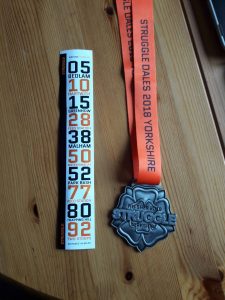 ag was a sufficient warning. At 92 miles in and feeling pretty broken you return to Pateley Bridge for the final major test, Two Stoops (also known as Nought Bank). Another 1.5miler breaking 20% at times was beyond me… After much pain, suffering, and (ashamedly) a little walking I reached the final summit. A stunning descent off the moorland returns you to Nidderdale and an undulating 10mile spin takes you back to the event base.
ag was a sufficient warning. At 92 miles in and feeling pretty broken you return to Pateley Bridge for the final major test, Two Stoops (also known as Nought Bank). Another 1.5miler breaking 20% at times was beyond me… After much pain, suffering, and (ashamedly) a little walking I reached the final summit. A stunning descent off the moorland returns you to Nidderdale and an undulating 10mile spin takes you back to the event base.
The route, the people, the food / drink stations, and the beer & burger tent at the finish were all superb; as is the bling.
One to return to…who else fancies it next year?
The Deva
~by Kath Finn
Out playing – Deva Middle distance last weekend with Bob Muirhead and Helen Farthing who completed the Olympic course. Paddy has always said this is a good, really well organised race but I haven’t done it before. I thought it lived up to its reputation. Very well organised, closed roads, closed river(!) organised car parks, official tours of transitions, a goody bag to rival
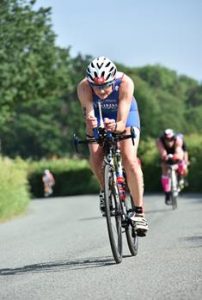
Christmas, tee shirts in woman’s sizes, loads of very visible bike course referees, etc. As with any race there were a few things which weren’t perfect but overall excellent. Don’t know what the others think? I had a good, but very painful race – first river swim, it’s not me in the photo, good bike spoilt by an impressive tangle on the dismount line when I tried to fit through a gap that wasn’t there and took myself and two others out. They were incredibly polite! Then the run from hell, but can’t win them all. pb and cracked the 5 hour 30 barrier for a half. Great day out, Chester is very pretty, recommend.
Trawlerman Tri
~by Dave Hollingham
Great fun at the trawlerman triathlon today. Demi sprint distance so very short.
400m swim, 8.75km bike and 3.6km run. Haven’t seen the results yet but I think my bike made up for the usual slow swim.
It was a really entertaining course with a pool swim around buoys, a varied circuit with a 600m straight ish fast section followed by 100,180, and 90 degree bends in fast succession. Narrowing sections,uphills downhills, cobbles and a fast 180 bend all packed in to a 1250m loop!
Tight transition area leading to a maze style running track where the longer courses had longer out and back loops within the park. Very creative.
Don’t know where I came, hope to have been the fastest from the ‘8mins plus’ swim time group.
Really don’t care though. It was great fun and then there were junior races as well so Louis helped and cheered me before I returned the favour a few hours later.
Ultra Training
~by Vikki McGarry
Training for the Lakeland Trails Ultra 55km on 8th July 2018 (which I believe from Angela White now, is actually 58km).
Last Saturday we set off from Ambleside for the second time, hoping on this occasion to complete the full first half cutting back more directly from Grasmere to Ambleside covering about 40km.
Heading up to Kirkstone pass there is a nice trail to begin with but unfortunately it comes out on the road just before the tortuous final punishment on concrete near the top. We hoped this time to find our way down the other side without taking a wrong turn but we still lost time as we went the wrong way around an old barn. Retracing our steps continuing to Hartsop we passed the first cafe which looked really nice. We continued on to Patterdale and Glenridding which was full of people enjoying a lovely day strolling around with Ice Creams. That was not for us as we drank our isotonic fluid and gobbled a chocolate bar. Then I think we went a bit wrong as we climbed very steeply past Lanty’s tarn, after which you can make reasonable progress.
I have to say I did check the forecast before setting off – no rain. So I did not pack my waterproof, so obviously Ray lent me his and he got soaked when the heavens opened as we approached Grisdale Tarn. Again we probably descended too soon from the right of the valley to the left. Had we continued we would have found there was a bridge further up. Oh well only an extra 500m distance and 100m of climbing!
The initial descent was not for running, well not by me but after that it was a lovely gentle path all the way to the Travellers Rest where everyone was sat outside drinking their beer. I had to pass by again and this time onto Grasmere which was crowded with tourists and cyclists. My reward was to shuffle as best I could up Red Bank, now my run was as fast as Ray’s walk. Once at the top there is the best view ever of the Langdale Pikes from Loughrigg with a lovely bench which sadly I could only admire. Near the end now, only need to skirt the lower trail around Loughrigg before a very steep descent back to Ambleside, where it was of course too late to go to the cafe.
It will be touch and go whether I can complete it in the 12 hour time limit. I will be ecstatic with anything less than 11 hours. The average time for my age appears to 10.5 hours so time will tell if there’s life left in the old dog yet!
I don’t know how you fell runners do it!
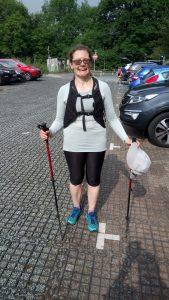
Velothon Wales
~by Sylvia Chudley
Velothon Wales 8 July
140k in the heat – the high point being the uphill, the closed motorway treating us like an oven, Garmin registering 37. It’s a great event, fantastic scenery with masses of support from the Welsh villages: any excuse for a party on the street. There were bells, pans and drums and regular dousing from garden hosepipes – all very welcome. Thanks to excellent coaching, my training actually worked and I behaved like a fit old bird, not exactly flying up the hills but almost (in my terms) and I finished with a smile on my face.
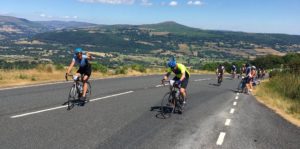
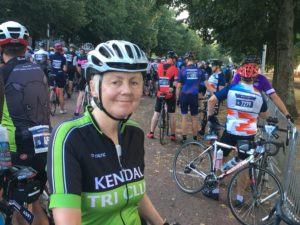
No, I am LAKESMAN!
~by Darren Brown
Lakesman 2018 in the bag. What a journey to the day and what a challenge completing it. More than happy with the result, and considering I’d never run more than a half marathon (once) I was pleased to just get around the run course in one piece!
The swim began at 6am. Mass deep water start (not really deep, you could stand in it). The horn went off before I even realised it was coming and we were off! 25 buoys to go around a rectangular course. The first leg out seemed to take forever, but I got in the groove fairly quickly and thankfully it never seemed too crowded in the water. I managed to front crawl the entire course and never felt the sense of panic that so often appears on long OW swims. Eventually got round and out of the water for a slightly wobbly run the couple of hundred metres up to the transition tent.
With the weather looking a bit grim I opted for a cycling jersey and arm warmers (both Kendal Tri club, of course) over the tri suit. Thankfully a volunteer was handy to help pull the arm warmers over my wet arms and pack away by swim gear into the blue ‘bike’ bag. Out to the bike and off onto the course.
With a fairly quick spin down the A66 out of Keswick to the west, the bike started well. Then course turned south into a headwind and got a bit lumpy with hills, and the workload started to increase. Once the course turned northward up the coast things sped up dramatically. From Whitehaven almost up to Silloth, the strong southerly wind kept the speed up but the pedalling became relentless as I wanted to make the most of this fast section. Turning south at Blitterlees it became painfully obvious how much assistance the wind had been giving us, as everything slowed and became a grind, with hills and wind slowing everything right down. Even guys on tri bikes with aero helmets were struggling here. A 32km loop back to the coast and I got to enjoy the tailwind again for a brief while before being battered by the winds on the second turn south. From here on it it would prove to be a test of will and determination, with strong headwinds all the way back to Keswick.
Thankfully back at transition, time to lose the cycling jersey and put on the running shoes.
Out onto the run course. With my history of running injuries and lack of run training this was always going to be the toughest part of the course. 5 laps of 8+ km with several out and backs and repeated sections of road, collecting a wristband every time round. At the start I felt a light-hearted agression to those with 4 or 5 bands when I was only on my first lap. By the end I was really feeling for those who still only had 2 bands when I had 5 and was feeling like I had nothing left. The marathon was pretty brutal, but the support from the crowds and the fantastic volunteers at the aid stations made it much more bearable. The Results Base van on one section of the course was blasting out classic 80’s metal, which was great for motivatingme to stop walking and get back running. I met up with my best friend on lap 2; I had been ahead of him by about 30 minutes over the course so far but he had caught me on the run. We agreed without communicating it to finish the race together, motivating each other to keep moving. Seeing my wife and kids once a lap added to my motivation to get round. Massive kudos as well to Peter Bascombe and other friends who were out to support us and keep myself and Dan Malcolm in good spirits. There was always a smile on my face despite the pain in my legs. Finally I reached the end of the run course. I ran down the finishing chute with my 5-yr old daughter holding my hand and running with me. I felt very proud and amazed for having completed this and to see the pride in my daughter’s eyes at her dad, especially on Father’s Day.
The Lakesman is a bit of a special race. I can’t comment on Ironman branded races having never done one, but the Lakesman is really well organised, with fantastic volunteers and race officials. The BTF official was out on the run course, shaking hands and congratulating people, it all felt like a big family. I would highly recommend it. Will I do it again? I swore yesterday on the run that I never would, but the agony of the day is already fading and being replaced by a massive sense of achievement and pride, not just at completing my first full-distance event, but pride at being part of something so special. So who knows, watch this space….
Swim 1:24:28
T1 9:19
Bike 6:51:23
T2 5:31
Run 5:49:17
Total time 14:19:58
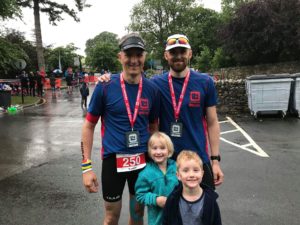
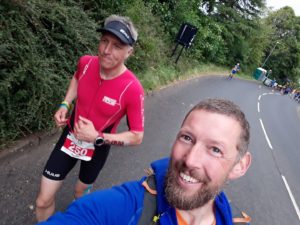
I am LAKESMAN!
~by Dan Malcolm
The Start
My kids are in Kendal Triathlon Club Juniors and I’ve been taking them to events for a few years now. A few years ago I got talking to somebody about iron distance races and remember contemplating the prospect of swimming 2.4 miles, biking 112 miles and running a marathon. Who are these people? How could you do that? The seed had been planted though…
After a great summer holiday in Cornwall where I’d done some nice long runs along the coast and swam most days I thought “hmm, maybe I’ll join the kids and give this triathlon thing a try”. I’d assumed that triathlons were usually run around towns or in an athletics environment – most junior events are run on cycling tracks and running tracks. I learned about the more adventurous side when somebody told me about the Helvellyn tri. Oh right, so you swim in a lake, bike through the mountains in the Lake District, then run up a mountain? That could be fun I thought.
If you’re thinking of joining a tri club, just do it. Don’t wait until you feel fit enough to qualify, don’t assume you’ll be laughed at by men with shaved heads and sunglasses wearing Mad Beastard Tough Mucker event t-shirts, just get out there. Turning up at Kendal Tri Club for the first time wasn’t that intimidating at all and I fitted right in to the regular swim sessions with the friendly coaches and members. I wasn’t that quick at swimming, but persevered and reached the dizzy heights of “lane 4” which tends to combine quite fit men expending a lot of effort with women swimming more efficiently at a similar speed. Run training was just an extension of the local trail and fell runs I’d been doing on and off for years. Biking involved me swapping mountain biking for road biking, which I’m still not quite sure about ….
My first race was a half iron distance event in 2016, Tri Hard’s “A Day in the Lakes”. This went well, I surprised myself a little with a decent result (for a forty-something busy Dad anyway…). I realised that maybe this iron distance thing was doable after all. Some other Kendal Tri club members did the Lakesman that year and had really good races – it was the obvious choice for anybody in Lakes looking for their first full distance race.
I’d casually considered the Lakesman when looking for races to do in 2018, but it had sold out. “Ah well, maybe next year,” I thought. I put my name on the waiting list anyway. The main problem was with this was that I got an email in December offering me a place. A quick chat with my wife and I was in. I must have been keen because I offered to do all the ironing for the year in return to make up for the time I’d spend training.
Getting Started
Training started in December. I followed a plan on TrainerRoad – a program you use on your laptop or phone / tablet to do turbo trainer workouts, which provides full triathlon training plans. The bad weather we had over winter and early spring made it easy to do the indoor bike workouts and swimming and running aren’t a problem in winter. I knew that disappearing for hours during the daytime at weekends wouldn’t be an option and tried to slot in workouts without blowing a massive hole in the middle of prime family time: A run while the kids were at swim training, cycle or swim during lunch hour, 5AM turbo training sessions. I think the longest turbo trainer ride I did was a 4 hour session in March, nice and cosy in the garage during some spectacularly cold and windy weather.
Some tips for fitting in training around work and family life:
- Early morning workouts are “free”. Get up at 5:00 on a Saturday, train for 4 hours and you’ll feel great. You can join your family at 9 and give them your full time for the rest of the day. This early morning time is yours, it is still dark, the world is peaceful and most people are asleep – you have time to live in the moment. You are soaking in your own sweat in the corner of a garage looking at the German language side of a hedge-trimmer box. The one rule about early morning workouts is that nobody admits they’re tired later in the day. Depending on how well you sleep in general, you’ll probably need an early night before or after to make up for the early start. It won’t be that kind of early night either – you might be missing time you normally spend with your partner, so don’t overdo it.
- Plan workouts and talk to your family about the best time to do them. Don’t sit there waiting for the perfect moment. You’ll get stressed because you haven’t fitted it in or annoy people with a last-minute announcement.
- None of the above works. Training for long races takes time, you are probably spending more time training than most “normal” people. Keep an eye on things, be thoughtful.
- Sunday night is ironing night
The plan included a long run every other week and I cautiously eased up the distance. I also ran a few of the local Kendal Winter League fell races and could feel my running speed improving. The suffering of an all-out 40 minute fell race seemed to pull up the long-run pace that I could sustain comfortably.
About 10 weeks to go
In terms of “nailing” workouts, January to March were probably my best training months. There was a minor blip due to a week away followed by some awful faffing with replacement bike parts. Then the weather improved, which shouldn’t have been a problem, but it was. It sounds really strange, but I’d got into the habit of the turbo training sessions – the computer told me exactly what to do and I did it and the numbers showed me getting stronger on the bike. This worked fine in the cold weather but I couldn’t face that corner in the garage once the weather improved. And it improved enormously with long beautiful sunny days. This threw me initially and I needed to rework my familiar training habits. It was simple in the end. Replace the hard interval sessions on the turbo with outdoor hill reps (why does the Greyhound have to be my local hill? It’s literally 2 minutes away…). The medium intensity and long rides could be done on the road (no more long rides on the turbo trainer!).
I started thinking more about the practicalities of the race, reading lots of race reports, blog posts and forum discussions. Would I really end up peeing on the bike to save myself a few minutes? Would the “wheels come off” halfway through the marathon, slowing me down to crawling pace? I’d read loads of race reports about sub 3:30 marathon runners being reduced to a walk in an ironman. I soon realised that this was the make-or-break moment of a triathlon at this distance. Everything is about running well. I love that light-and-easy feeling you get when you’re running on fresh legs. I wondered how I’d be running out of T2. I had done a flat 20 mile training run at 7:26 min / mile pace and reckoned I could have maintained this for another 6 miles, which would give a 3:15 marathon time. I knew that my pace would be a lot slower after the swim and bike but it was encouraging. I did a few brick runs after long rides and found myself being able to set a decent pace but I had no idea how it would go on race day.
Yes, peeing on the bike is a thing. Some people piss in their tri-suits during a race and it goes in their shoes and everything. The stuff I read made me think twice about buying used bike shoes – feel free to Google “triathlon bike piss” for further information or go straight to this particularly amusing forum post on Slowtwitch at https://forum.slowtwitch.com/forum/Slowtwitch_Forums_C1/Triathlon_Forum_F1/I_Pissed_my_Bike_and_I_Liked_It_P3467762/
Race day approached rapidly. I hadn’t followed the training plan to the letter, averaging 10 hours per week during these last 10 weeks. I’d missed some longer rides in April, but managed to fit enough in over the last 6 weeks to feel prepared, including a full 112 miler. Some days I just stopped stressing about fitting in workouts and had a rest. I deliberately reduced the distance of the last 2 long runs, preferring shorter, more frequent runs to avoid injury. I was confident that I had enough endurance to do a half-decent run and didn’t want to push it. Looking back, my run mileage was actually ridiculously low. Maybe I wasn’t “respecting the distance” or something and would suffer on race day.
On the plus side, I was training regularly and consistently, I didn’t get ill or injured and I was feeling as ready as I would ever be. I started to think about my goal race time. I thought I’d be swimming “1 hour something”, riding around 6 hours (let’s say “5 hours something”) and running “3 hours something”. It would just be a case of 9 hours plus whatever all those “somethings” added up to. It looked like I’d be aiming for the 10h 30m – 11h range. The 5:30 bike split I’d entertained earlier in the year seemed out of reach based on the pace I was averaging on long rides. I knew that the bike course was “flat” (ish, a big “ish”), but I wasn’t able to fit in a day out to recce the course and really had no idea of how it would go on the day. More to anticipate, the excitement was building!
Race Weekend
Try this: Next time you feel nervous and have that strange empty feeling in your belly, take a deep breath and try to convert that worry and anticipation into something positive. Think thoughts like “bring it on” if you have to. Does it help? That nervous feeling is double-sided – it feels bad sometimes, but it will also be what drives you on in new and exciting situations. I was nervous about the prospect of messing up the race with a wrong turn during the swim, a mechanical problem or bike crash, pulling a muscle during the run. But still … bring it on. I was feeling pretty positive as race day approached – it would be ridiculous to put all that time into training and then dread the race itself.
Race Day
This is it, it’s really happening, I can’t believe it, here we go, have I got everything? I hope so, the hooter is literally going to go in 10 minutes. The hooter, OMG the hooter, yep that actually makes me feel quite nervous. I’d recently watched a video of last year’s race and I couldn’t forget the sound of the starting klaxon. Now I know why. Of course! It’s the hooter that sounds at that moment when you start moving. One minute you are waiting, the next you are moving. You will be in the race, the race!
We’re walking down the carpet towards the lake. The line of orange buoys extends an intimidatingly long way out. I try to break down the distance. The first milestone is the yellow buoy where the half distance swim turns right to go around the island, the second will be the right turn where the full course turns right. “The full course”? I’m doing an iron distance race, I’m about to swim 2.4 miles, in a race, what am I doing? It’s early in the morning (6:00AM) but it’s not too early. It’s time, no excuses. Phil and Marie, the event organisers high-five each competitor as they make their way down to the lake. I get to the edge of the water and don’t break my step, straight in, walk for a bit until the water gets to waist height (the water level is very low), then launch myself into a warm up. I need to get moving – I don’t want that “first few lengths ugh out of breath” feeling 2 minutes into the race. I get as much of a warm-up in as I can, then get ready for the hooter. The hooter – that’s enough rambling about hooters I think, but seriously, the hooter. I manage to find somewhere to stand up – this happens to be right at the front, not where i’d planned on starting, but the start line is very wide and it’s quite spread out so there aren’t many people behind me.
Nobody seems ready, but we quickly get into position as an oddly delayed “10 9 8 7” dances across the water from one of the piers where the officials and spectators start the countdown. And that’s it, the hooter sounds and we’re off! No sprint start, just nice steady long strokes, breathing every 3, sighting every third breath. We pass a few buoys and it’s going well. I’m warmed up and feeling good. Before I know it the yellow buoy is my next target. Conditions are good. The water is flat, there’s no glare to deal with and every time I look up I seem to be on target. We reach an orange buoy and everybody turns right. Wow, that means we’re already at the last buoy in that long line that had seemed so distant earlier on. I’ve been swimming my own race so far, vaguely conscious of where other people are around me. I look over to my left and see a fellow swimmer moving quickly next to me. His stroke rate is way higher than mine and his legs look low in the water but he’s just as quick. The name “Sinky Bum” comes into my head for some reason. “Yep, there he is, I’m still with Sinky Bum,” I think a few minutes later. I’m not taking the piss. Maybe I look like that when I swim, maybe I caught him when he raised his head to sight, but the name sticks in my head. I realise that the people I’m swimming with now are probably going to finish the swim at the same pace I’m swimming at. I think it might be a good idea to try and catch a draft now, swimming close behind somebody to save some energy. This is exciting, I’m thinking tactically rather than just hanging on for dear life. I manoeuvre myself behind Sinky Bum and try to follow his feet. The feet disappear, I don’t get it. It looks like he’s shifted to one side. I’m a “polite” distance back, rather than playfully tickling his toes and I don’t think he’s deliberately trying to stop me getting a lift, but he’s impossible to follow. I look up and try again. Then with somebody else. It proves more trouble than it’s worth. With the water level being a lot lower, mud is being churned up from the lake bottom and visibility isn’t very good. I think that’s what’s making it difficult, the feet I’m trying to follow get lost in the murky water as soon as they’re more than 50cm away. I decide that the water I’m in is probably surging in vaguely the same direction that I want to go in and give up on the drafting idea. This keeps me busy for the long return stretch before we turn right. At this point, our next target is the finishing arch on the lake shore. I’m feeling good, my work rate is steady rather than all-out and I start contemplating the next leg.
Exiting the water I feel a little wobbly as I make the transition back to the vertical world. Helpers are on hand to keep us upright. I stride up the soggy carpet, slide off my goggles and hat and reach around my back to unzip my wetsuit. This is the first of a few minor mishaps. I start to jog up the carpet towards the changing tent and bike, wriggling my arms out of my wetsuit as I go. I suddenly realise I’ve dumped my hat and goggles somewhere. My brand new expensive goggles and souvenir race swim hat! Damn! I feel incompetent and frustrated but push it out of my mind as I continue jogging up the hill. I’m breathing hard but I’m warmed up from the swim and my legs are starting to work. Strip wetsuit, on with bike shoes. At this point I notice that I’m still wearing my swim hat and my goggles are sitting on my head – I’d just moved them up when I got out of the water. Mishap 1 averted. Helmet on and I’m off towards my bike. Another mishap: I’d removed my timing chip when taking off my wetsuit and it was still sitting on the floor where I’d got changed. Massive fuck-up 2 averted, just…
Bike
I pull my bike off the rack, jog for the mount line, hop on and go. It’s a totally new environment now, the breeze feels cool on my wet tri suit and there’s a rushing sound in my bike helmet as I pick up speed. It’s still early and Keswick is quiet as we make our way through the familiar streets. Shops and cafes that I’ve visited on relaxing days out fly by. We exit the town onto the A66. I have that 5:30 bike split in mind and will be eyeing the average speed field on my bike computer. I basically need to average 32 kph (20 mph) for the ride to hit that time. The ride begins with a comfortable flat stretch. I’m not chasing anybody or worrying about people overtaking me and keep things steady for the first 30 minutes. It’s a smooth classic A-road TT ride at first and riders are travelling at speed with very little effort, perfect. I’ve been breaking down the course – flat at the start, some hills, a long flat stretch up the west coast that looks like it’ll have a tailwind. The first hilly stretch slows us down but there’s still a long way to go and I’m banking on bumping that average speed back up on the flat middle stretch.
The aid stations are run by volunteers who hand out bottles of water and energy drink for you to grab on the fly – it’s amazing. I don’t need to top up when I hit the first aid station but have a good look as I pass. They’re normally based in a layby on the road. A line of volunteers holds out bottles of water, energy drink and food. I’m ready for a refill when we get to the second one. “Who’s got water?” I shout out as I approach. “He’s got water, over there,” somebody helpfully replies. The fourth person in line holds out a bottle and I pluck it from his hand as I pass, squirt it into the aerodynamic bottle between my aero bars (essential equipment if you’re aiming for a 5:30 time) and sling it onto the grass verge with a load of other empties at the end of the aid station. Smooth. I feel like a pro in the Tour de France. The encouragement from the helpers gives a real buzz – they’re great.
Nothing that exciting happens on a long bike course like this. You can’t ride alongside people to chat due to drafting rules, you’re basically riding a very long time trial. I reflect on how many of the people doing iron distance events would prefer sportive-style rules that allowed riding in groups – there’s plenty of time to think random thoughts as I chug along. The race seems to have settled now. I trade positions as we descend towards Egremont, picking off a few people, before getting overtaken by people who had come out of the water later and are making up time. There’s no point chasing people. Either they’re faster and I’ll wear myself out trying to keep up, or they’re going too fast and will be slowing up later.
Hey, where’s the flat section and tailwind that I’ve been counting on going to start? There’s a final long climb after Whitehaven and then, sure enough, we’re cruising along slightly downhill at around 40 kph. I see my average speed begin to creep up and start to feel good about the bike leg. Long course bike racing goes on a bit though and I start feeling a bit of discomfort – achy shoulders and a bit saddle-sore – tri suits are never that comfortable for a long bike ride. I’m matching the speed of a rider in front of me, staying back to avoid drafting. He sits up to take a break at the top of a small climb. I don’t feel like overtaking him so have a quick stretch and big gulp of energy drink – this really helps and I start to feel comfortable again. It feels good that everything has gone to plan so far. My average speed creeps up to 34 kph, enough in the bank to make up for the climbs in the last third perhaps?. Quite a few people have come out to watch and encourage us and I shout “thanks” back to most of them, trying to be as friendly as possible to offset the Judge Dredd look of my visored bike helmet. The ride along the west coast continues with a beautiful stretch along the coast all the way up to near Silloth. At this point there’s a short loop where we head back down, then out to the coast again to repeat the last section of the West coast stretch. “Oh,” I think as I round a corner and feel a strong head-wind. The wind has picked up more than expected.
I decide to stop for a toilet break at the next aid station, deciding that life is too short to piss in my tri-suit and shoes. There are only 2 portaloos and they’re both busy. They remain busy for 2 minutes. I’m wasting time, frustrating. I jump back on and head back out, wasting another 2 minutes further down the road by a hedge. Soon, the second loop is complete and I’m heading back to base. From my earlier route breakdown I know that that’s two thirds down and 40 miles to go. The continuing headwinds and climbs are tiring though – it feels like the wind is somehow changing direction in order to be as annoying as possible. I remember that the big gorilla sitting on it is the least aerodynamic thing about my bike setup and focus on staying as low as possible. I break the last bit down: First we take Cockermouth, then we take Keswick. There are plenty of climbs left and I see my average speed dip to 31 kph. The final stretch back to Keswick, that beautiful stretch of road alongside Bassenthwaite Lake, feels like it should be really fast, but it drags on and I can feel a strong headwind. My average speed creeps up again – I won’t quite make 5:30 but I’m not far off. I keep a steady pace and start to contemplate the fact that I have a marathon to run. I feel like I’ve paced the bike well but have no idea how I’m going to feel.
The blast back though Keswick is exciting. We we wind through streets lined with spectators who are watching the bikers come in and clapping on the runners on the shorter “Lakesman Half” race. A 5:40 bike, not bad – I can blame 10 minutes on the wind and aborted toilet breaks.
Run
Thankfully there would be no more mishaps during this race. I’d got through the swim without going off course, survived the bike without a breakdown or crash, just the simplest of disciplines to go: a run around town.
The assistance from the volunteers in transition is amazing. As I rack my bike, a volunteer shouts my number through to the changing tent. Somebody is ready with my bag and passes me my running gear as I sit down, then puts away my bike shoes and helmet. It’s a quick change, into my running shoes, start my watch and go. The moment of truth was approaching, would I enjoy that light and easy running feeling, at least for some of this race? Probably not.
There are 5 laps of 5-and-a-bit miles (8350 metres apparently) and you pick up a wristband at the start of each lap. At the end of the 5th lap you run down the finish chute and through the finishing arch.
I have a stitch as I begin the first lap through the park – I rarely get stitches and put it down to the contorted position I’ve been holding on my bike. I know it will pass in time. I’d sworn to myself that I’d run at an easy pace for the first 2K. My quads feel a little dull after 112 miles on the bike – it has a strange anaesthetic effect and I’m finding it hard to judge my pace. My Garmin watch is being silly so I haven’t got that to guide me either – 5 mins on and it hasn’t started GPS. I restart it as I run, being extremely careful, this is not the time to catch a toe and launch myself into the road. I concentrate on following the course for the rest of the first lap. It’s a bit of a contrived loop in and around Keswick with repeating sections on the same road for a couple of miles. It proves easy to follow with the marshalls pointing the way at each turn, but I concentrate carefully the first time around.
I’m not paying enough attention to my pace. I’d set out too quick, running the first lap at 4:29 min/km pace. Idiot. There’s a long way left to go and as I exit the park on the second lap and begin the slight uphill to Booths, I feel a tap on my shoulder. It’s The Man – I owe him for that last lap and he wants paying. I settle into a more sustainable pace, frustrated that I hadn’t taken things easier on the first lap.
I’m feeling tired but steady as I begin the third lap. I cross paths with fellow Kendal Tri Club member Darren and have a brief exchange. “How you doing?” I ask. “Could be better,” he replies. “Yeah, knackered,” I mutter. Cheerful moment that!
3 laps down and I back off from the idea of an all-out effort on the last 2 laps. The thought of digging deep has no appeal right now. I don’t have much appetite but force down energy gels and water from the aid stations. It becomes a real effort to hold a pace that feels so effortless with fresh legs. I begin to wonder whether I should have done a few more long runs, but at the same time I don’t beat myself up about it. I think back to the first time I’d heard about iron distance races and the respect I’d had for people who did them – here I am running pretty strong and heading for the finish. This is amazing, I’m going to finish an iron distance race!
Lap 4 means that I can start drinking coke at the aid stations (my rule, you can have some earlier if you want). There are only 2 laps to go. While waiting for the much-needed sugar and caffeine-rush, I try to break down the rest of the race into sections. There’s still a lot left to do.
I see some people who are just starting out on the run. The encouragement from the marshalls and spectators keeps everybody going and it feels like nobody is going to give up at this point. People do iron distance races in a wide range of times. Some are held back by injuries or illness, others are just starting out. That person coming in close to the cut-off time might not even have been able to run for 10 minutes at a time last year. Their achievement in even getting onto the run course is up there with that of a top 10 finisher. In fact, the people taking a little longer are probably having to draw on their mental reserves even more than fitter or more experienced competitors. Respect! Obviously, there’s a lot of crap going on in the world and flogging yourself around a swim, bike and run course is the least of some peoples’ worries, but you can’t help but admire the effort that you witness at a race like this.
I’m hoping to see my family in the park as I start the last lap where we’d vaguely agreed to meet but don’t see them in the crowd as I pass through. It’s in the alleyway near Booth’s where I hear somebody shout “Yeah, come on Dan!”. It’s my wife and children, it’s so nice to see them. “Last lap, see you at the finish, 35 minutes!” I call out as I run past. Whoops, just set myself a time goal, no slowing down now! Their smiles cheer me up, but the final lap still feels as tough as the fourth. I tick off each point as I pass it for the last time and the miles pass quickly. At the last sharp right turn I hear “Eye of the Tiger” coming from a speaker at a slightly underwhelming volume. Too little, too late…
I jog through the Kenyan Corner aid station for the last time, holding up my right wrist with its 5 wrist bands jiggling merrily in a Andy Murray style victory pose. The wrist bands are mine and nobody else is having them. I’m in the 5 Wristband Club now and this has special privileges, including being allowed to turn left towards the finish chute, rather than heading out for more laps. There’s a final stretch lined with people cheering and I’m grinning like an idiot showing them my wrist bands.
Spectators are allowed to join family and friends as they finish the race. We hadn’t planned anything, but the grinning faces of my 2 daughters appear on either side of me as I get to the carpeted finish chute. I stop to make sure they’re both with me and we run the final 30 metres together to the finish line (I should point out that they were both easily capable of dropping me at this point if it came down to a race).
And that’s it! The race is done, I’m a Lakesman! I have swum 2.4 miles, cycled 112 miles and run a marathon. Run time 3:30, total race time 10:25.
“Ugh, that was tough, ” I say, “not really sure this is my thing, that run felt hard.”. It’s soooo nice to be able to stop running. I stay on my feet and walk around for a while rather than collapsing onto the ground, easing the transition from effort to rest so that my legs don’t seize up. My wife is looking at the results online – ”Er, I think you were 16th overall, 5th in your age group. ‘Not really my thing…’, you sure?” I’d had no idea where I was positioned in the race. I’d exited T1 (transition 1 after the swim) in 32nd place. Finished the bike in 34th (that stupid wait for the toilet!), gained 2 places in T2 (the transition from bike to run), then made up 16 places on my badly paced run. More grinning ensues.
After
So that’s it. I can’t believe I’m sitting here a week later. It’s all over but the great memories are there and I’m secretly enjoying sleeping in and having a break from training. Then again, I keep seeing posts from people who are signing up for next year and it’s proving hard to resist. That could be me doing the ironing for another year.
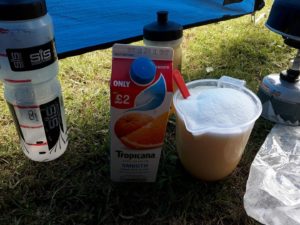
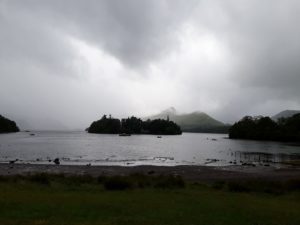
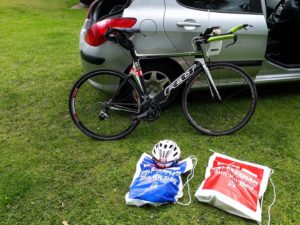
Giant Sportive Lowther Castle
Giant Sportive from Lowther Castle 3rd June 2018
It was to say the least a nervous start, the weather had been great until the morning of the event and was now dull and drizzly. I had spent the day before cleaning my bike and was completely oblivious to a small tear in my rear tyre that I spotted only after we had racked the bike on the car the night before and the shops had shut. The type pressure seemed ok but I was concerned by the stony surface at Lowther Castle.
Set off very slowly only to find my back brake was not releasing properly, I disengaged it completely but this slowed me down on all the descents as I was extra cautious having only my front brake to rely on. I realised that it was only the brake lever that was not releasing so I was able to sort that whilst riding ensuring it was not engaged particularly during the Watermillock slog. As I continued to cycle my confidence grew and the tyre held up however my bottom bracket was also past its best and my bike was creaking through all the climbs. The weather improved and I really enjoyed the second half of the event, through tiny villages in spectacular countryside with hardly any cars on the road. If you’re ever in that area look for the sign post for King’s Meaburn it is very quaint.
I would say thanks to Giant Kendal for a very well organised sportive. It was great to see our head coach Paddy Finn at Watermillock warning me of steep climbs ahead. He was not wrong there! Great soup and sandwich provided at the end. I would have liked a drink either hot or cold at the end as I was very thirsty.
One week later and I have a new tyre, new bottom bracket and fully working brakes! Check your bike before your event is my best advice!
Race Report: ROC Triathlon Abersoch: Going for Green
This was the first time for the ROC and there were 70 starters of which four were women. Looking at the forecast the weather was going to be hot, but that’s the same for all competitors.
The format of the race was:
1.2k sea swim
30 mile road bike to the bottom of Snowdon
12k run up and down Snowdon via the summit on the Watkins trail
30 mile road bike back to Abersoch
1k beach run
On race morning there was a warm breeze, full sun and no cloud cover. I felt relaxed and a bit nervous. There was a cut off time at 12 noon 4k up Snowdon. If we missed it we would be turned around to head back on the return leg, missing out the last 2k and the summit. At the briefing they tried to reassure us by saying that making it up to the 4k point was still a fantastic achievement and we would get the ROC medal, but it would be with a grey rather than a green ribbon. I wanted to get to the summit and achieve the green ribbon, so it was game on. I had done my calculations and gave myself plenty of time, I expected to do the swim and T1 in around 30min, my bike would be about I hour 45 which would give me 1 hour 45 to get up to the cut off, which should be fine. I would not run much of the Snowdon ascent as the height gain is 1,000 meters in four miles and I am not a strong hill runner.
Accompanied by Phil (aka Dobbie), I went to transition, racked my bike, and headed down to the beach to check out the swim start. The waves were big, and it was hard to see the swim buoys, they seemed to be having difficulty putting buoys out and the last one was put in place with one minute to the start! This was not great as we began the swim not really knowing where the route was. This confusion only increased as the swim progressed!
The swim was hard due to the conditions – we couldn’t see the buoys or other competitors, so I focused on relaxing, trying not to take on too much water and sighting when I could. It felt a long swim and hard work although I found a small group of swimmers and settled in to the race. I exited the water after 40mins, so I was already behind my schedule.
I headed out of T1 on to the bike course which was on the main A road along the coast to Porthmadog then inland though Beddelert and on a few miles to a farm where T2 was situated. The route was fast and undulating, I had been concerned about the traffic, but it didn’t seem to be an issue. I spent the early part of the bike checking out how I was feeling after the swim and wondering if I may get a second sight of my breakfast. Surprisingly I felt fine and settled down to riding. I had chosen my TT bike as I wanted to ride it in preparation for another race. Most other competitors were on road bikes. We cycled into a headwind for the first 20 miles, although this helped keep us cool. The final 10 miles were hot with a few welcome shady areas. I enjoyed the bike.
As we approached T2 I started to think about the next stage, a quick look at my watch reassured me as I was a few minutes quicker on the bike than expected. I was hoping that my running bag had been successfully transported to T2 by the organisers. I didn’t need to worry, the friendly marshals sorted us out and told me that I was the first lady through. That was great, although I was sure that I would be overtaken on the ascent at some point.
I quickly changed into my trainers and set out on the track. I had 1 hour and 30 minutes to reach the cut off, that should be enough. I had decided to carry 1 litre of water as the briefing had said there was water at the summit and emergency water at the cut-off point. We also had to carry emergency equipment that included full waterproofs and foil blanket! We had more chance of getting heat stoke than hypothermia! I felt hot and as expected stopped running and settled into to walking as quickly as I could. Part way up the track I saw my friend and her daughter, they really lifted my spirits. I stopped for a few moments, gave them a sweaty hug, and then headed off. About 10 minutes later two of the other female competitors caught up with me, we chatted about the race before they pulled ahead.
I was starting to feel the heat and, although I was drinking plenty of water I was probably not eating enough. Then suddenly the track turned, and above me was the 4k cut off. I looked at my watch 11.40am, phew I was going to be fine, the summit was on. I would have the green ribbon on my medal. I checked my water and decided not to take water at 4k as it was for emergencies, I would get some from the summit check point feed.
The last 1k of the climb is more like scrambling and it was busy with other people, so progress was hot and slow. I finally made it to the top ridge and felt a welcome breeze. As I went through the check point I asked for some water, but they didn’t have any. I was disappointed but not worried as I can descend well and would soon be back at the 4k cut off and pick some up there. It took me a bit longer than expected to get down as lots of people were coming up. Also I had sprained my ankle four weeks earlier had it still hurt on the uneven descent. I reached the 4k cut off only to find they had run out of emergency water! I knew I was towards the back of the field by now, but I was going to finish. I continued to descend and sped up as the path became easier.
By the time I reached T3 I was thirsty and feeling a little sick. There was plenty of water, so I stocked up and quickly headed back out on my bike. It was so hot, but we had a good tail wind. However, I couldn’t use the tri bars or push hard as I felt sick. I calculated that stopping to be sick would take longer and make me more dehydrated, so I cycled at an easy pace and tried to keep taking on food and water. After about 15 miles I started to feel better, but the damage was done, I didn’t have the energy to up the pace again. My time for my second bike leg was the same as my first but it could have been faster.
Still I didn’t care I was happy, I had expected to take seven and a half hours and I was going to be under eight hours so that was a great result for me in these conditions. Back into transition and then 1k run on the beach past the finish line out to a break water and back.
Over the finish line, Green medal and third woman. Happy and, yes, my mojo is back, I am going to sign up for next year hopefully with a few more members of Kendal Tri Club.
It’s a game of 3 halves…..
Cast your minds back to Summer 2017, picture the scene I’m sat at my desk in the office casually chatting to a colleague on plans for 2018 when he lets slip how wonderful Chester Deva Standard was that year and that he has designs on entering the Middle. Well my competitive streak and lack of willpower need no coercing into joining him. Loads of time to train, I think to myself, yep sign me up i’m in 100%!
Summer comes and goes as does Autumn and even most of Winter, now I must point out that whilst I hadn’t exactly started any training plan I was ticking over nicely and during this period also moved house, renovated a house, moved house again, gotten married, had a honeymoon and Christmas also descended.
Round rolls January and I say to myself a solid 5 months to get this done ready for June 3rd. Well Feb passed as did March & April and by the time May landed I’d resigned to just going and enjoying myself and what would be would be.
June 1st arrives and I set off to Chester with the wife to do some shopping and settle into digs. A horrific nights sleep courtesy of some very loud Argentinians and a very wet Saturday morning arrived. Bleery eyed and not too keen a little ponder round Chester for some breakfast and a return to digs to get some rest. Registration later that day and a nice meal out before hitting the hay for a 5am start. Another terrible nights sleep with the impending 5am alarm have I/haven’t I missed it dance saw me about 30seconds away from not even bothering with the race.
Meet up with mates albeit a bit late before heading to transition – so far so good. Set transition up – check, put timing chip on – che…. where’s my timing chip? Upturn bag, no timing chip. Hot foot it back to digs – wife sound a sleep and i’ve no key – bugger. Hot foot it once more back to registration where the wonderful team sorted me out with a spare chip – phew!! Back to transition finish setup, put chip on, put wetsuit on and head for briefing. I’d made the start line!!
A quick briefing including all the usual information and a genuine piece of solid gold at the end – “Don’t be shit!” The race start was now looming so I go to pull up wetsuit and get zipped in only to find my original timing chip in my tri suit pocket – aaarrrrggghhh FFS!! You complete donut!! This was the conclusion to a very fraught morning, being ill prepared, rushing and not eating.
After the events of the preceding months I had no aspirations for the race but had set some goals – I wanted to be out of T1 in under an hour, average 16-18mph on the bike and hopefully hit a 2 hour run to finish in 6:00 – 6:30
Steady away as the swim sets off, pairs jumping into the murky depths of the Dee about 5 seconds apart. Downstream to start fro 250m an all going well, a quick u-turn before tackling the long drag against the current. This is a first for me having done sea, lake and pond swims before so not really used to the current of the river changing my course at will. A few well diverted 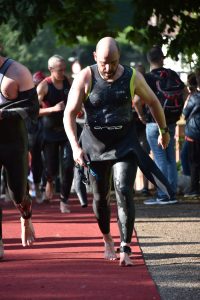 strokes help miss some jetties and overhanging trees and I feel comfortable and in a rhythm untill……….I manage to take on board a lung full of water which completely halts me as I a) do my best not to puke into the approaching swim pack and b) try to grab my breath back. I manage to set off again but feeling somewhat discombobulated as I fight my way against the current again. Stroke, Stroke, Sight, Breathe as I pick off buoy after bouy – finally the end is in sight, or not as the swim actually heads around the bend and more buoys appear. Stroke, Stroke, Sight, Breathe as I head what seems to be further and further away from the finish – finally the turn point is in sight with a yellow and red buoy next to each other. I start my turn to see yet more buoys upstream clumped together – bugger!! Off I set again, finally reaching the turn section and a quick dash downstream again before clambering out of the river like the monster from the black lagoon!! A quick look at the watch reveals a 40min swim – well inside the goal for leg 1. A quick run up the steps into the park, locate my bike, de-suit and off we go on leg 2.
strokes help miss some jetties and overhanging trees and I feel comfortable and in a rhythm untill……….I manage to take on board a lung full of water which completely halts me as I a) do my best not to puke into the approaching swim pack and b) try to grab my breath back. I manage to set off again but feeling somewhat discombobulated as I fight my way against the current again. Stroke, Stroke, Sight, Breathe as I pick off buoy after bouy – finally the end is in sight, or not as the swim actually heads around the bend and more buoys appear. Stroke, Stroke, Sight, Breathe as I head what seems to be further and further away from the finish – finally the turn point is in sight with a yellow and red buoy next to each other. I start my turn to see yet more buoys upstream clumped together – bugger!! Off I set again, finally reaching the turn section and a quick dash downstream again before clambering out of the river like the monster from the black lagoon!! A quick look at the watch reveals a 40min swim – well inside the goal for leg 1. A quick run up the steps into the park, locate my bike, de-suit and off we go on leg 2.
The bike leg is 2 lapper with a short detour around the beautiful sights of Wrexham Industrial Estate on lap 1. A fast course with not too many climbs, but it is a far cry from any cycling I have done of late. With my goals in mind I settle into a steady pace pushing along nicely on the fast sections but reserving enough for later down the line. It’s a belting hot day so fuelling would be especially crucial, I have a mental note to take on fluid and eat some little jelly block things every 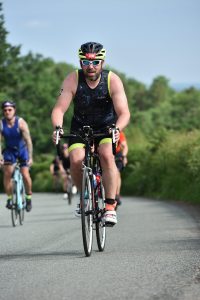 20-30 mins. All is going well as I complete lap 1 and ride through the bottle exchange swapping out my bottles for the second, shorter, lap. I managed to only grab 2 waters instead of anything electrolytey which would prove a downfall as the day progressed. Chipping off the second lap 5 miles at a time my legs became heavy and cumbersome with literally every muscle screaming and on the verge of pinging it had now become a test of endurance and preservation to ensure I could even walk off the bike. As the monotony of one section bore down on me my mind wandered and I’m not even sure if I had a momentary sleep, all I remember was ‘coming to’ as my pedal clanged on the kerb top and my wheels spat up dust and chipping from the kerb edge – one wrong move and I’d be down for sure. I managed to avoid disaster but my concentration had gone, my heart rate was up and I just had to focus on getting to the end. As ever in these events many words of encouragement were shouted as the hordes passed me my only resolve being many of them were fresh legged and Standard distance athletes. As I approached the nasty little climb towards the end of lap 2 I knew the bike leg was almost over, another quick glance at the watch and I’d averaged 17.1mph – I was delighted!!
20-30 mins. All is going well as I complete lap 1 and ride through the bottle exchange swapping out my bottles for the second, shorter, lap. I managed to only grab 2 waters instead of anything electrolytey which would prove a downfall as the day progressed. Chipping off the second lap 5 miles at a time my legs became heavy and cumbersome with literally every muscle screaming and on the verge of pinging it had now become a test of endurance and preservation to ensure I could even walk off the bike. As the monotony of one section bore down on me my mind wandered and I’m not even sure if I had a momentary sleep, all I remember was ‘coming to’ as my pedal clanged on the kerb top and my wheels spat up dust and chipping from the kerb edge – one wrong move and I’d be down for sure. I managed to avoid disaster but my concentration had gone, my heart rate was up and I just had to focus on getting to the end. As ever in these events many words of encouragement were shouted as the hordes passed me my only resolve being many of them were fresh legged and Standard distance athletes. As I approached the nasty little climb towards the end of lap 2 I knew the bike leg was almost over, another quick glance at the watch and I’d averaged 17.1mph – I was delighted!!
Just a half marathon to run now! It was now 11am and if my hopeful 2hr run came to fruition I’d be running throughout the hottest part of the day. I set off slowly just trying to get my legs back from the bike but the sun is beating down and it is soon very apparent that it is going to be a very long afternoon. Lap 1 of 3 seemed like it was never going to end, adopting a run/walk approach my legs still heavy and sore from the bike with muscles still on the verge of going pop I take it easy and relent to the fact this is going to be hard hard work. As I cross the bridge at the end of lap 1 I see the smiling and cheering face of my Wife which lifts my mood no end, my legs now so sore I’m on the verge of tears. “Just 7km to go then its the last lap” is all I could tell myself to try 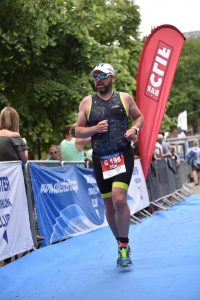 and trick my head into making my legs work. Another very long 7km run/walk with the sun still beating down, trying to get as much water on board as possible but as was everyone else this became increasingly difficult. The 2 hour run was no nothing but a distant memory, I’d be lucky to finish at all. I slowly picked my way around the course looking for every inch of shade but there simply wasn’t much to be had. As I rounded the corner for the bridge a second time my wife still cheering me on I was now only 7km from the finish. Familiar faces I’d seen on Lap 1 were well and truly finished and basking in what was now for them a glorious sunny afternoon, for me 7 more torrid kilometres loomed. Water was now scarce to drink and you had to scavenge for half empty bottles to tip over your head but the end was in sight. I ended up walking quite a bit of Lap 3 and chatting to a fellow struggler – we shared tales of exploits good and bad and what the race had been like for us and what events we had planned. With 2km left to go I set off determined to run to the finish, not fast but it was running and after the extended period of respite walking and chatting I now felt better than I had done all run. Crossing the bridge for the final time the finish tunnel seemed to take forever to arrive but there it was, one final beep of the timing system as I crossed the line collecting my medal and souvenir Deva towel.
and trick my head into making my legs work. Another very long 7km run/walk with the sun still beating down, trying to get as much water on board as possible but as was everyone else this became increasingly difficult. The 2 hour run was no nothing but a distant memory, I’d be lucky to finish at all. I slowly picked my way around the course looking for every inch of shade but there simply wasn’t much to be had. As I rounded the corner for the bridge a second time my wife still cheering me on I was now only 7km from the finish. Familiar faces I’d seen on Lap 1 were well and truly finished and basking in what was now for them a glorious sunny afternoon, for me 7 more torrid kilometres loomed. Water was now scarce to drink and you had to scavenge for half empty bottles to tip over your head but the end was in sight. I ended up walking quite a bit of Lap 3 and chatting to a fellow struggler – we shared tales of exploits good and bad and what the race had been like for us and what events we had planned. With 2km left to go I set off determined to run to the finish, not fast but it was running and after the extended period of respite walking and chatting I now felt better than I had done all run. Crossing the bridge for the final time the finish tunnel seemed to take forever to arrive but there it was, one final beep of the timing system as I crossed the line collecting my medal and souvenir Deva towel.
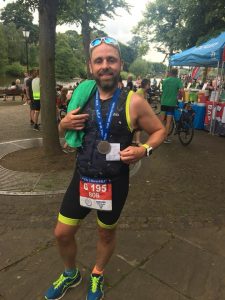 A run time of 2:32 and a total race time of 6:33 I was only just outside my target but on a day of relentless heat, a frantic morning and little to no race preparation I was relieved to have finished and pushed myself through the distance.
A run time of 2:32 and a total race time of 6:33 I was only just outside my target but on a day of relentless heat, a frantic morning and little to no race preparation I was relieved to have finished and pushed myself through the distance.
The Eagle has landed…..
My next race is 190 Miles………on foot
A member of the tri club, I’ve done a few sprint tris. I don’t swim at all well, I’m not much of a cyclist and, whilst I run, I’ve not much speed although I do seem to be able to just keep going. So it came as a complete surprise to receive a Special Award for single discipline performance at the recent AGM, for the ultras I ran last year.
Jane suggested some of you might be interested in a bit of a blog about my adventures so I thought I’d share some of my thoughts as I’m working towards this year’s big one.
On 12th May I’ll be on the beach in St Bees for the start of the 2018 Northern Traverse. Organised by Open Adventure, it’s a continuous endurance race along Wainwright’s coast to coast route to Robin Hood’s Bay. From the Irish Sea to the North Sea, 190 miles across 3 national parks, the Lake District fells, Yorkshire Dales and (bleak) North York Moors.
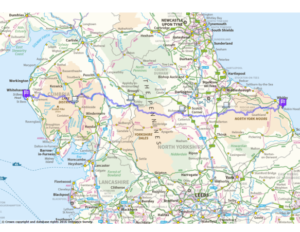
The organisers provide four feed stations along the route, where we have access to a drop bag, but apart from that, participants must be fully self supported, self-navigating and receiving no external help other than buying supplies from a shop or pub which is available to all participants.
We have five days to complete the event with generous cut offs at each feed station. We must not stray more than 200m from the prescribed route without returning to the point at which we left it. Time penalties or disqualification may result should we do so.
The most common question I get asked is “how do I train for something like this?, always preceded by a variety of assertions and opinions as to my mental state
In this case, I participated in the NT in 2016 so I have the advantage of having done it before……..but that’s also the disadvantage of knowing what I’m letting myself in for.
I have a view that ultrarunners share some form of amnesia which effectively blocks out the excruciating pain of running mile after mile on rough ground with blisters on all toes and a liberal application of Compeed plasters in various states of disarray decorating the feet. I can vaguely recall tears and despair around mile 150 when my legs wouldn’t obey a request to climb another hill on the Cleveland Way. I remember experiencing a complete loss of appetite and the endless struggle to force fluid down. Then there were surreal moments when complete strangers seemed to pop out of bushes and other ‘hiding’ places, as I saw it, addressing me by name and saying I was doing well. How did they know who I was and where to find me? Well, we all carry trackers so folks can follow our progress – Flojo popped up twice – nothing like being stalked!
And, after finishing, my legs and feet became so swollen that my ankles disappeared as the body’s natural response to such significant trauma, acute inflammation, kicked in, in a major way to repair the damage.
So, why then, am I attempting it again? I’m two years older and, now in my 60th year, shouldn’t I be taking life easier? – ask well-meaning non-running friends, with startled expressions and slow head shaking. “Bonkers” – such an overused word – but describes something that is outwith the user’s ability to imagine. I just smile.
The Northern Traverse route takes us through beautiful iconic landscapes, mountains, lakes, rare-bird nesting moorlands, the mystery of the centuries-old Nine Standards: running the gauntlet of woman-swallowing swamps and bogs, navigating miles of bleak moorland at night shrouded in thick fog, struggling with sleep deprivation……
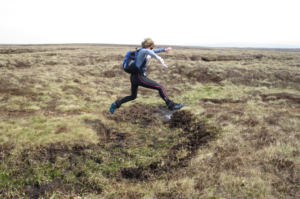
Well, would you want to taste a fine wine or enjoy a stunning sunset only once? Each time is a bit different but equally enjoyable.
Pushing myself to my physical and mental limits and succeeding delivers the same sense of inner contentment.
Does having prior knowledge help me to prepare? Well, yes it must do. However, I only discovered fell running six years ago and attempted my first ultra in 2013. I then fractured an ankle and foot and lost the next year to rehab. It’s been a steep learning curve – no pun intended.
I’m approaching this race as if it is the first time I’ve done it. That way I hope not to be complacent about any aspect. I start by considering what I can control and what I can’t.
I can’t control the weather or the route. In addressing those, I can recce the route and, so far as the weather is concerned, the winter we’ve had has given me ample opportunity to test all of my kit so I know exactly what works. It’s even allowed me to invest in some nice new stuff too
Training started late, at the beginning of February. My basic approach is twofold: a) what are my strengths and weaknesses for this event and b) what things are most specific and least specific.
I then spend the early weeks working on my weaknesses and the non-specific aspects and transition to my strengths and race-specific aspects closer to the event date.
Weaknesses abound but, in particular, I need to work on hills and speed so this is how I’ve spent February and March. It’s been challenging with the cold and so much snow but high-stepping through deep snow drifts and keeping traction on icy surfaces has provided a whole-body workout and probably helped a bit with stamina.
My strength is the ability to keep going, so I leave endurance to the weeks closer to the race. Specific to the race is the route and my nutrition plan and kit. Now into April, I’ve been out doing some long days, recceing the route and testing my nutrition and kit.
Clearly, it’s a bit more involved that this but I have evolved the basic structure over the few years I’ve been doing this and found it seems to have merit for me.
You can’t cater for everything you’ll encounter; the bogs, swamps, sore feet and fatigue you can anticipate. However on a recce last week I could not have anticipated an attack by an eagle owl whilst on the Cleveland Way. When something with a four-foot wingspan is coming at you through the air, it produces some adrenaline-fuelled erratic speed work that I could well have done without!
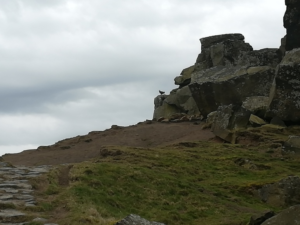
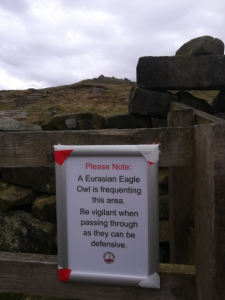
I’ll post the tracker detail on the FB page once it’s known so you can follow my (slow) progress should you wish to do so.
Thanks for reading!!
Angela